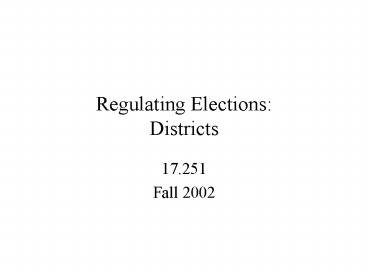Regulating Elections: Districts - PowerPoint PPT Presentation
Title:
Regulating Elections: Districts
Description:
Major ways that congressional elections are regulated. The Constitution ... Davis vs. Bandemer (1986): California & Indiana. Ruling. Partisan gerrymanders justicible ... – PowerPoint PPT presentation
Number of Views:52
Avg rating:3.0/5.0
Title: Regulating Elections: Districts
1
Regulating ElectionsDistricts
- 17.251
- Fall 2002
2
Major ways that congressional elections are
regulated
- The Constitution
- Basic stuff (age, apportionment, states given
lots of autonomy) - Federalism key
- Districting
- Campaign finance
3
An aside about the statesRun-off vs. plurality
rule
- Brazilian election example
- The South
- Interest in instant runoff
4
Districting
- Apportionment
- Method of equal proportions
- Required in House races since 1820s
- Effects
- Possible malapportionment
- Responsiveness
5
Apportionment methods
- 1790 to 1830--The "Jefferson method" of greatest
divisors - Fixed ratio of representation with rejected
fractional remainders - Size of House can vary
- 1840--The "Webster method" of major fractions
- Fixed ratio of representation with retained
major fractional remainders - Size of House can vary
- 1850-1900--The "Vinton" or "Hamilton" method
- Predetermined of reps
- Seats for state Population of State/(Population
of US/N of Seats) - Remaining seats assigned one at a time according
to largest remainder - Alabama paradox
- 1940-2000--The method of equal proportions
6
Method of equal proportions
- Results in a listing of the states according to
a priority value--calculated by dividing the
population of each state by the geometric mean of
its current and next seatsthat assigns seats 51
through 435. - Practically This method assigns seats in the
House of Representatives according to a
priority value. The priority value is
determined by multiplying the population of a
state by a multiplier. For example, following
the 1990 census, each of the 50 states was given
one seat out of the current total of 435. The
next, or 51st seat, went to the state with the
highest priority value and thus became that
state's second seat.
Source http//www.census.gov/population/www/cens
usdata/apportionment.html
7
Priority values after 2000
Seat State State seat
Priority 51 CA 2
23992697 52 TX
2 14781356 53 CA
3 13852190 54
NY 2 13438545 55
FL 2
11334137 ... 431 IA 5
655598 432 FL
25 654377 433 OH
18 650239 434 CA
53 646330 435
NC 13 645931 436
UT 4 645684 437
NY 30
644329 438 TX 33
643276 439 MI 16
642646 440 IN
10 642025
8
Reapportionment Change in 2000
9
Reapportionment Court Challenges
- Department of Commerce v. United States House of
Representatives, 525 U.S. 316 (1999) - The Census Bureau cant sample
- Utah v. Evans
- Imputation challenged
- Mormon missionaries miscounted
10
Districting principles
- Compactness and contiguity
- Equal population
- Respect existing political communities
- Partisan (or other) fairness
11
Compactness
- General idea min(border/area)
Good
Bad
12
Compactness in the real world Nebraska
13
Compactness in the real world
14
Compactness in the real world Florida
15
Contiguity
- General idea keep the district together
Bad
Good
16
Contiguity in the real world NC
17
An aside Machine politics in The American
Scientist
Cake-cutting algorithm
Greedy algorithm
Simulated annealing
http//www.sigmaxi.org/amsci/Issues/Comsci96/comps
ci96-11.html
18
Contiguity in Mass. 6th CD
19
Equal population
- Implied by having districts
- Bad Many states before 1960s
- Illinois in 1940s (112k-914k)
- Georgia in 1960s (272k-824k)
- Good equality?
20
Equality in 2000
Source National Conf. of State Leg.
21
Respect for existing political communities
- Iowa
- Politicians like it
- May be better for citizens
- Getting more difficult with computer drafting of
districts and (nearly) equal populations
22
Partisan Fairness
- Results should be symmetrical
- Results should be unbiased
Seats
Seats
60
50
Votes
Votes
50
50
23
Partisan Fairness
- What is the right responsiveness?
50
Votes
50
24
Swing ratio
- Measure of responsiveness
- Concept
- Swing ratio ?Seatsp/?VotesP
- Various ways to measure
25
Why the swing ratio is rarely 1
Dem vote
Dem vote
26
Empirical swing ratio(with data from 2000)
With 2000 Swing ratio 1.91
27
Racial fairness
- From 15th amendment
- The right of citizens of the United States to
vote shall note be denied or abridged by the
United States or by any State on account of race,
color, or previous condition of servitude. - Voting Rights Act of 1965
- Prevented dilution
- 1980 Mobile v. Bolden
- S.C. says you have to show intent
- 1982 VRA extension allows effect
- 1990 Justice dept. moved to requiring
maximizing minority representation through
pre-clearance
28
Some Court Cases
- Equal population
- Colgrave v. Green (1946) political question
- Baker v. Carr (1962) Tennessee state districts
- Gray v. Sanders (1963) Ga. unit rule
- Wesberry v. Sanders (1964) one person, one
vote doctrine - Veith v. Pennsylvania (2002) no deviation allowed
29
Some other court cases
- Partisan gerrymander
- Davis vs. Bandemer (1986) California Indiana
- Ruling
- Partisan gerrymanders justicible
- Partisan gerrymanders arent allowed
- This wasnt a partisan gerrymander
30
VRA Cases
- 1965 Dilution outlawed
- 1982 Extension Republican DOJ Racial
gerrymanders - 1993 Shaw v. Reno
- Race must be narrowly tailored to serve a
compelling govt interest, or. - Sandra is the law
- Non-retrogression doctrine
- Districting overturned in GA, NC, VA, FL, TX, LA,
NY (but not IL) - Page v. Bartels (2001) incumbency protection
OK, even if its only minority incumbents
31
A Word about Massachusetts































